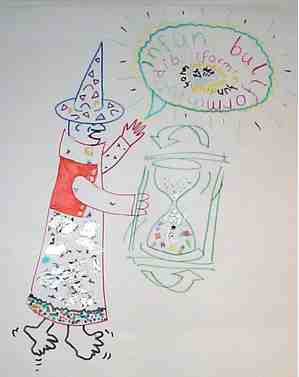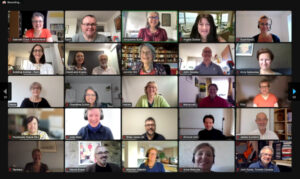First published in Effective Consulting, Vol. 1, No. 5.
This is a two-part article: Part 1 explained that underlying every theory of management or organisation is a metaphor. It described eight commonly used metaphors and Gareth Morgan’s method for analysing and facilitating organisations to change. Part 2 describes a new approach, Symbolic Modelling, which uses client-generated metaphors to facilitate individuals to understand and change themselves and their organisations. Symbolic Modelling can be used as an alternative, or as a supplement to Gareth Morgan’s methodology. |
Symbolic Modelling developed out of a five-year study of David Grove, one of the world’s most innovative psychotherapists. Penny Tompkins and I wrote Metaphors in Mind: Transformation through Symbolic Modelling so that Grove’s use of Clean Language with client-generated metaphors would be more widely known — not only within the therapeutic community but also among people who are interested in metaphor in other contexts: business, organisations, education and health.
When someone says “I keep running up against a wall in this company,” David Grove assumes the metaphor is a perfect description of their experience. Thus, what kind of wall it is, where it is, its size and shape, and the direction of the running will all be symbolic of what it is like to have that person’s experience.
In addition to Grove’s work, Metaphors in Mind incorporates ideas from cognitive linguistics, self-organising systems, evolutionary dynamics and Neuro-Linguistic Programming (NLP).
Embedded Metaphors
Ordinary conversation is littered with (mostly unconscious) metaphors. In fact it is ‘hard’ to ‘put together’ an ‘everyday’ sentence which does not ‘contain’ a ‘hidden’ metaphor:
My mind has just gone blank.
There’s a gap in my knowledge.
I’m feeling down today.
These sentences are not obviously metaphoric until ‘blank’, ‘gap’ and ‘down’ are examined more closely. We call these and similar expressions embedded metaphors since their metaphoric nature is disguised in ordinariness and familiarity. Once you start to recognise embedded metaphors you will notice them everywhere. 1
Clean Language
David Grove discovered that when we ignore another person’s metaphors or introduce our own, we unwittingly ‘contaminate’ their experience. This is fine in ordinary conversation, but not if you want to facilitate that person to become aware of their inner symbolic world that has such an influence on the way they think, feel and behave. So how can we help another person discover and develop their own metaphors without introducing our own? To solve this conundrum Grove devised a number of very simple questions and a way of asking them called Clean Language. 2
As I show in Part 1 of this article, Gareth Morgan might analyse a company and decide that it is being run like a machine. Or he might suggest that a manger use the metaphor of a spider plant to help re-design their organisational structure. This is in sharp contrast to Symbolic Modelling where you would use Clean Language to facilitate the manager to discover their own metaphor for the organisation, and then use that metaphor to help them achieve their outcome. For example:
(M = Manager. F = Facilitator. Bold is used to highlight the format of some of the common Clean Language questions. These can be asked of any metaphor.)
M: I want to understand why our organisation is not more successful.
F: And when you want to understand why your organisation is not more successful, your organisation is like what?
M: You could say it’s like a machine.
F: And what kind of machine?
M: [Pause] It’s like a combine harvester I suppose.
F: And is there anything else about that combine harvester that your organisation’s like?
M: It’s flexible with interchangeable parts depending on the type of crop.
F: And is there anything else about it being flexible with interchangeable parts?
M: Timing is so important. Too early or too late and you miss the opportunity. It’s no good harvesting until the crop is ready.
F: And then what happens?
M: We go through the whole cycle again.
F: And where could that cycle come from?
M: It’s the natural order of things. [Pause] That’s right. We have to educate the new recruits in the nature of the cycle. They try to rush things or they give up too quickly. If they knew about the cycle …
This short exchange demonstrates the fundamentals of Clean Language. Clean questions are ‘clean’ because the facilitator is careful only to ask about the client’s metaphors, to use their exact words to do so, and not to introduce any metaphors of their own. 3 Because of this, clean questions can be used in a remarkably wide range of circumstances.
The best way to give you a sense of how Symbolic Modelling works is through examples. So the rest of the article describes how Symbolic Modelling has been used in three organisational contexts: executive coaching, new product development, and creating a corporate metaphor. It should be easy enough to extract the process from these examples and apply it to yourself or your clients.
From Bombs to Batons
The initial coaching session with a manager in a multinational company revealed he wanted “to be able to hold the line against aggressive senior managers.” As I listened to him describe his work, I noted down some of his metaphors: “I have to defend my people, “I blew up,” “I was in a Catch 22 situation,” “His method is to drill you and then attack,” “The troops are falling by the wayside,” “His lieutenant had a word with me,” “I can lose it in the heat of the battle.” When these expressions are taken together it is easy to identify the manager’s underlying metaphor: Work is a battle.
When I repeated his exact words back to him he said he was “shell-shocked,” and we laughed. I asked “And where does being in ‘the heat of the battle’ come from?”. He replied immediately, “You must defend your territory to be on the winning side.” Then I enquired, “And when you must defend your territory to be on the winning side, what would you like to have happen?” Traces of emotion flickered across his face before he shook his head and said “Not to have to defend myself.” I asked him what metaphor he would prefer instead. After trying on and rejecting the idea of a sports team, he settled on an orchestra — which I then helped him explore by using Clean Language. Later, he used this metaphor to gauge his, and others’ behaviour: Am I participating like a member of an orchestra? When am I the first violinist and when am I playing the triangle? When I chair a meeting, are we all playing the same tune and am I conducting appropriately?
The manager recognised that seeing his work as a battle had significantly influenced the way he responded to his colleagues, and in particular those “higher up the command chain.” Over the next few months he gradually altered his behaviour to more closely fit his orchestra metaphor. And surprise surprise, senior managers started acting differently towards him.
Launching New Balloons
I recently worked with a Director of a company who was about to launch a new product which needed a high degree of autonomy. He was unsure how the product could be seen to be an integral part of the existing company. Through the process of Symbolic Modelling he devised a metaphor of a central launch pad from which a hot air balloon could rise and descend. The balloon was navigated by its own captain and yet was always connected to the launch pad by a cable which both defined its scope and provided safety. This arrangement allowed for other balloons to be launched, and the possibility that when a balloon became large enough the cable could be severed and replaced with a looser, even more autonomous form of organisation. Clean Language facilitated the Director to explore a multitude of aspects of the metaphor: the balloon, the qualities of the captain, the launch and landing gear, the relationship with outside observers, the round table strategic plans, the effect on the public looking at the balloon as it was flying, etc.
One interesting feature of this approach is that I had no idea of the product in the Director’s mind because I was working entirely within the logic of the metaphor. Also, one of his colleagues who was observing the process felt compelled to join in saying she had never had such a clear insight into his thinking. She added suggestions to the way the balloon arrangement could work and was able to voice her concerns by questioning the metaphor. They later noted how staying within the metaphor eliminated the defensiveness which often occurs in such situations.
Creating a Corporate Metaphor
Many companies have created corporate mission and vision statements, but few have created a corporate metaphor. New Information Paradigms (NIP), a niche software development company specialising in knowledge management systems, is one that has. Assisted by consultant Caitlin Walker, 4 each of the 16 staff identified a number of metaphors for ‘the company and where it is going’, for ‘me as a member of NIP’, and for ‘my relationship to NIP and the way I would like it to become’. As a result, an entire wall next to the coffee machine became adorned with symbolic drawings and metaphor maps. The staff were taught Clean Language so they could respectfully investigate each other’s metaphors. Next, each of the company’s four teams was facilitated to incorporate their personal maps into a group metaphor. With this accomplished, the teams paired up to discuss areas of overlap, disagreement and synergy, and to produce an integrated metaphor. Finally, all four teams combined to produce a single composite corporate metaphor. And the result? A far better understanding of what they were collectively trying to achieve and how they could work together. NIP found that “meetings are shorter, more constructive and we reach a common understanding quicker. We are more able to remain objective and yet it allows people to access their emotions without having to be overt about it.” Caitlin Walker adds that the process gives them another perspective from which to find agreement and uncover problems: one group metaphor contained a river, and when they saw there was no way for people to cross the river, they realised “there it is, that’s the problem!”
|
Recognising a good thing, the company has devised its own applications for Symbolic Modelling. When a NIP customer has difficulty specifying their requirements, the sales team use Clean Language to help them create a metaphor for what they want. When the metaphor is translated into traditional business-speak, the customer feels understood and NIP knows it has high-quality information. For example, take the company that considered its information system as like a series of interconnecting reservoirs where water levels dynamically changed depending on the amount of rain, evaporation and usage. The customer wanted to more closely monitor water levels, predict when new reservoirs are needed, and not get caught out in a severe drought. Once explored, the metaphor was converted into the language of demand forecasting, contingency planning and quality control. Back at the office, the sales people relayed this information and the customer’s metaphor to the software designers.
NIP says metaphors provide a ‘common definition language’ with which to discuss a project and to get to the underlying reasons why something is the way it is. The software developers create their own metaphors to help explain the technical design features to the sales and marketing teams, who in turn use these in their presentation to customers. In the process the software developers have found unexpected uses for their systems.
New Information Paradigms has identified three main advantages of using metaphor. In their words:
“Metaphors work because they transmit enormous amounts of information and richness.”
“Presenting ideas and situations as metaphors gives the receiver the opportunity to understand the message being communicated to them, in their own terms. Perhaps more importantly, any points raised, or criticisms voiced about the metaphor (with its inherent gaps, flaws etc.) isn’t personal — the scope for taking offence is greatly reduced … there is ‘room to manoeuvre’ without being ‘pinned down’ … to get all metaphorical.”
“Encouraging participants, in a group, to come up with their own metaphors for (apparently) the same thing — a product, a customer situation etc. — often creates a mental or virtual ‘shared space’. In this ‘shared space’, it becomes possible to explore individual metaphors, there is scope to merge or use them as stepping stones towards a metaphor that everyone has contributed to, or at least that can be subscribed to.”
Concluding Remarks
Facilitating an individual or group to recognise the unconscious metaphors that shape their worldview, that guide their decisions, and that constrain their choices, encourages insight and heightens self-awareness. To facilitate without suggesting, presupposing or imposing your own metaphors requires the skilled use of Clean Language.
And the whole process can be taken to a deeper level by facilitating an individual or group to symbolically self-model the way their system works. Then, rather than trying to make change happen, new learning occurs, problems get solved and creativity is stimulated organically, as a by-product of the self-modelling process.
References
Morgan, Gareth, Images of Organisation, Sage, 1986/1997.
Morgan, Gareth, Imaginization, Sage, 1997.
Lakoff, George & Johnson, Mark, Metaphors we Live By, University of Chicago Press, 1980.
Lawley, James & Tompkins, Penny, Metaphors in Mind: Transformation through Symbolic Modelling, 2000
Notes
1. Lakoff and Johnson’s Metaphors we Live By, was the first and is still the best introduction to the significance of metaphor in everyday language.
2. For the ‘Nine Basic Clean Language Questions’ and further examples of their use see Less is More … The Art of Clean Language.
3. Of course Clean Language introduces metaphors and directs attention — all language does that. Clean language is ‘clean’ because it only uses ‘universal’ metaphors (of space, time and form) which leave clients free to process, respond and answer with whatever information they consider relevant.
4. Caitlin Walker’s work with NIP has been presented in a video entitled “Working with Imagery and Metaphor in Creativity”; produced in 1999 by the Open University for their MBA course. See also the web sites of NIP, www.nipltd.com and Training Attention, www.trainingattention.co.uk.











